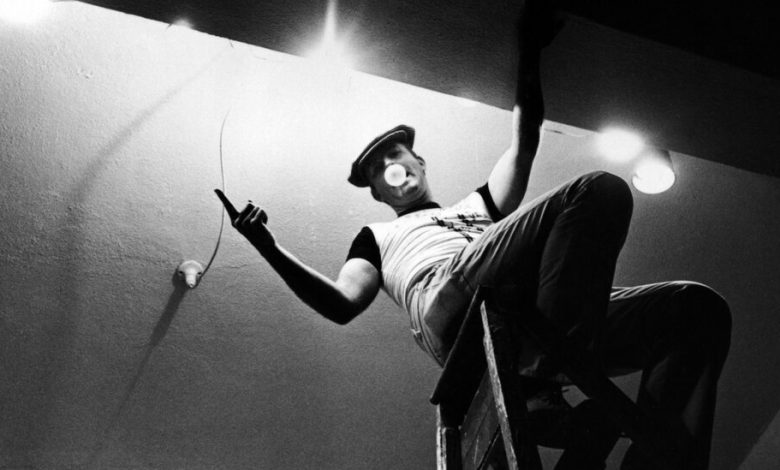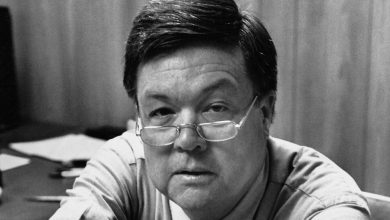Robert Irwin Helped Us See the Light

Robert Irwin, who died last week in San Diego, at 95, had one of the most restless, inquiring minds of any artist I have ever known. As the story goes, in 1966 he stepped back from one of his very ethereal, so-called abstract “dot paintings” — composed of small dots of near-complementary colors — and realized that the visceral, rather than optical phenomenon created by the painting was not the painting itself but rather the real and beautiful shadow cast by the canvas against the wall. He never made another painting. From that point forward he wanted to make works of art without frames, without limits, which he did, continually questioning the very nature of art in almost every visionary work he made.
Irwin coined a term, “conditional art,” for his practice. Sometimes nearly invisible, his art was always a function of the circumstances of its being. In graduate school at the University of California, San Diego, I walked every day beneath one of his most simply beautiful works: He had placed large angled planes of blue-violet chain-link fence into the midst of a tall grove of Eucalyptus trees on the campus — its weight completely disappears, becoming two long diaphanous scrims of pure color lifted high on silver poles, as if lowering a slab of sky into the trees, its violent tint heightening the green glow of their leaves. The work remains to this day, creating an effect of landscape that could never be expressed in a painting.
In 1974 at Pace Gallery in New York Irwin adjusted a single wall of the white rectangular room by stretching a white theater scrim a few inches in front of one wall. Many visitors stepped in and quickly stepped out, assuming the gallery was empty. But those curious enough to enter were treated to the strangest phenomenon: One wall appeared uncannily blurry, challenging assumptions about the space and the perception of a seemingly unfilled room.
One of his most magical works, made around the same time in Italy, at the Villa of Giuseppe Panza di Biumo, consists simply of a rectangle on a wall that at first glance might appear to be a picture of foliage. But if you look closer you understand that you are actually looking through an aperture, a sharp-edged window punctured through the thick walls of the old villa and opening onto a real tree outside. In addition to being a literal breath of fresh air in an art gallery, Irwin’s gesture completely reverses the history of painting in which a flat plane is used to feign a three-dimensional reality outside its frame. Here Irwin brings the actual world right to the viewer as a seemingly two-dimensional, and quite beautiful picture, close enough to touch.
The primary medium of Irwin’s art is not painting or sculpture, nor walls and trees, but rather our perception, our curiosity, and our desire to make sense of the world around us. By often destabilizing our experience of light and space, his work forces us to construct a personal awareness of the very act of seeing.
Irwin’s life and his 60-year career, most of it conducted in Southern California, was kind of a continuous “teaching moment.” He was an actual teacher in his early career. Students who attended his classes included the artists Larry Bell, Ed Ruscha, Vija Celmins, Alexis Smith and even Chris Burden, whose thesis consisted of locking himself in a tiny school locker for five days — which Irwin argued was indeed art. Irwin would claim he had nothing to do with the art his students made. But that’s because he didn’t teach in any traditional sense of imparting what he knew. He was famous for teaching how to, as he would say, “become your own teacher.”
When I directed Dia Art Foundation we asked him to serve as an artist-architect to transform a 1929 factory on the Hudson River into a museum for the 21st century — now Dia: Beacon — I vividly remember him walking me to the center of the vast symmetrical open space to view the long rows of windows on the east and west of the building. Rather than tell me what he was thinking in terms of design, he asked me, in a Socratic dialogue, to observe the space closely, and to describe the difference in the color of light between the two sides — which I did, beginning to understand immediately his approach to the project. In the end, he created two symmetrical doors allowing entry from two subtly different sides of the building. Each visitor to Dia starts with a choice — their own choice.
While I wasn’t yet born when Irwin was teaching in art schools, I can say that over the three decades we have worked together, he has been perhaps my most influential teacher. Being with Irwin as he watched and questioned everything around him, every premise of art and our experience, I learned, among many other things, that a work of art succeeds when it challenges our perceptions to such a degree that it awakens us to reconsider our environment, and invests us with a greater potential to see.
Irwin’s own powers of observation were so great that for a time, as a young man, he was able to make a living betting on horse races — because if you are observant enough, not just of the animals but of every detail of the track and the jockeys and trainers, you might develop winning insights.
One of the coolest things about Irwin was that his worldview renounced the centuries old cliché that to be a great artist you must be filled with angst and unhappiness. He grew up a happy child in the sunshine of Southern California, a lifeguard during summers, famously good on the dance floor, and able to restore a hot rod to absolutely “cherry” condition. And that’s not irrelevant to his art. The miracle of perception is not confined to philosophical thinking.
Observing the quintessentially Southern California art of automobile restoration, Irwin once described to his biographer, Lawrence Weschler, his admiration for an average working kid doing the job: “Here was this ’29 [car], absolutely dismantled, I mean, completely apart, and the kid was making decisions about the frame, whether or not he was going to cad plate certain bolts…or leave them raw… But, I mean, real aesthetic decisions … Here was a 15-year old kid who wouldn’t know art from schmart, but you couldn’t talk about a more real aesthetic activity than what he was doing, how he was carefully weighing: what was the attitude of this whole thing? What exactly? How should it look? What was the relationship in terms of its machinery, its social bearing, everything?”
While he may have received some of the highest honors in the field of art, the MacArthur “genius” grant among them, Irwin was always grounded in the pleasures of the everyday. As long as I knew him, and for much of the nine and a half decades he lived, this deeply philosophical and accomplished man was almost always seen in faded blue jeans, sneakers and a T-shirt, a ball cap on his head and a tattered bomber jacket on his shoulders, with a fountain Coca Cola — his beloved elixir — in hand.
Irwin’s goal as an artist wasn’t to make objects, but rather to change the way we see. As he told his biographer: “If you asked me the sum total — what is your ambition? Basically it’s just to make you a little more aware than the day before of how beautiful the world is.”




